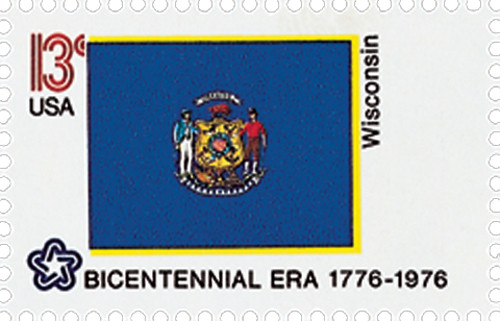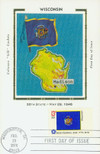
# 1662 - 1976 13c State Flags: Wisconsin
U.S. 1662
1976 Wisconsin
State Flags
American Bicentennial Series
• First time a sheet 50 had all different stamp designs
• Part of the American Bicentennial Series
Stamp Category: Commemorative
Series: American Bicentennial Series
Value: 13¢ First-class postage rate
First Day of Issue: February 23, 1976
First Day City(s): Washington, DC
Quantity Issued: 8,720,100 (panes of 50)
Printed by: Bureau of Engraving and Printing
Printing Method: Photogravure
Format: Sheet of 50
Perforations: 11
Why the stamp was issued:
The United States Postal Service celebrated the American Bicentennial with a full pane of the Union’s fifty state flags.
About the stamp design:
Wisconsin's state flag pictures a shield on a dark blue field with the state motto "Forward". Beneath it is the state animal, a badger. A sailor and miner represent that the people of Wisconsin work on water and land. The shield in the center represents Wisconsin's support for the United States.
In four areas surrounding the shield are symbols relating to the state’s main industries, agriculture, mining, manufacturing, and navigation. The cornucopia and pile of lead represent farm products and minerals.
Wisconsin's flag law was amended in 1979 to include the name of the state and the date it was granted statehood.
About the printing process:
Printed by the Bureau of Engraving and Printing on their seven-color Andreotti gravure press (601) which was their work horse for multicolored stamps.
About the American Bicentennial Series:
In the 1970s, America celebrated its 200th anniversary with hundreds of national events commemorating the heroes and historic events that led to our nation’s independence from Great Britain. The U.S. Postal Service issued 113 commemorative stamps over a six-year period in honor of the U.S. bicentennial, beginning with the American Revolution Bicentennial Commission Emblem stamp (U.S. #1432). As a group, the Bicentennial Series chronicles one of our nation’s most important chapters, and remembers the events and patriots who made the U.S. a world model for liberty.
Several of the stamps honored colonial life – craftsmen and communication. Other stamps honored important battles including Lexington and Concord, Bunker Hill, and Saratoga. Significant events such as the Boston Tea Party, the meeting of the First Continental Congress, and the Declaration of Independence were featured as well. The stamps also honored many significant people such as George Washington, Sybil Ludington, Salem Poor, and the Marquis de Lafayette.
Many of the stamps feature classic artwork. For instance, the set of four souvenir sheets picture important events recreated by noted artists such as John Trumbull. The Bicentennial Series also includes an important US postal first – the first 50-stamp se-tenant – featuring all 50 state flags. The format proved to be popular with collectors, and has been repeated many times since.
The American Bicentennial Series is packed with important US history – it tells the story of our nation’s fight for independence through stamps.
History the stamp represents:
On May 29, 1848, Wisconsin was the 30th state to join the Union.
When the first European explorers arrived in Wisconsin during the early 1600s, the main Indian tribes were the Winnebago, Dakota, and Menominee. Within the next 100 years, many other Native American groups moved into the region after being pushed from their lands in the East by whites – or to escape the warring Iroquois League. These tribes included the Sauk, Fox, Ottawa, Kickapoo, Huron, Miami, Illinois, and Potawatomi.
The French explorer Jean Nicolet became the first white person to set foot in Wisconsin in 1634. Nicolet was searching for a water route to China, and believed he may have reached that distant country when he landed on the shore of present-day Green Bay. The explorer came ashore dressed in a colorful robe and firing two pistols, making quite an entrance, but was disappointed when he was greeted by Winnebago Indians and not Chinese officials. Nicolet then returned to New France, today’s Quebec, reporting that America was much larger than anyone had guessed.
The French had long maintained friendly relations with the Indians in Wisconsin. However, in 1712, a war broke out between the French and the Fox Indians over control of the Fox and Wisconsin Rivers. The French won the war in 1740, but had severely weakened their defenses and damaged their relations with other Native American tribes in the area. The French and Indian War began in 1754. This conflict between France and Great Britain and their Indian allies ended in a British victory with the Treaty of Paris in 1783.
With the Quebec Act of 1774, the British made Wisconsin a part of Quebec. This angered Americans and helped to spark the American Revolution in 1775. That war ended with the 1783 Treaty of Paris, which gave all the land east of the Mississippi and south of the Great Lakes, which included Wisconsin, to the United States.
During the 1820s, settlers poured into the southern part of the state. Lead was discovered, and a demand for lead to use in paint and shot made mining more profitable. Many miners lived in shelters that were dug into the sides of hills – earning them the nickname “badgers.” This name came to be used for all Wisconsinites.
On April 20, 1836, Congress established the Wisconsin Territory. Madison became the capital of the territory, and Henry Dodge became the territorial governor. The Wisconsin Territory included part of present-day Minnesota, Iowa, and North and South Dakota. When the Iowa Territory was created in 1838, the Mississippi River became Wisconsin’s western border.
On May 29, 1848, Wisconsin joined the Union. At that time, its borders were established as they are today. The state’s population was growing fast. In 1840, 30,945 white settlers lived in Wisconsin. By 1850, the number had grown to 305,391. These settlers came from all over the U.S. and from various other nations, as well.
U.S. 1662
1976 Wisconsin
State Flags
American Bicentennial Series
• First time a sheet 50 had all different stamp designs
• Part of the American Bicentennial Series
Stamp Category: Commemorative
Series: American Bicentennial Series
Value: 13¢ First-class postage rate
First Day of Issue: February 23, 1976
First Day City(s): Washington, DC
Quantity Issued: 8,720,100 (panes of 50)
Printed by: Bureau of Engraving and Printing
Printing Method: Photogravure
Format: Sheet of 50
Perforations: 11
Why the stamp was issued:
The United States Postal Service celebrated the American Bicentennial with a full pane of the Union’s fifty state flags.
About the stamp design:
Wisconsin's state flag pictures a shield on a dark blue field with the state motto "Forward". Beneath it is the state animal, a badger. A sailor and miner represent that the people of Wisconsin work on water and land. The shield in the center represents Wisconsin's support for the United States.
In four areas surrounding the shield are symbols relating to the state’s main industries, agriculture, mining, manufacturing, and navigation. The cornucopia and pile of lead represent farm products and minerals.
Wisconsin's flag law was amended in 1979 to include the name of the state and the date it was granted statehood.
About the printing process:
Printed by the Bureau of Engraving and Printing on their seven-color Andreotti gravure press (601) which was their work horse for multicolored stamps.
About the American Bicentennial Series:
In the 1970s, America celebrated its 200th anniversary with hundreds of national events commemorating the heroes and historic events that led to our nation’s independence from Great Britain. The U.S. Postal Service issued 113 commemorative stamps over a six-year period in honor of the U.S. bicentennial, beginning with the American Revolution Bicentennial Commission Emblem stamp (U.S. #1432). As a group, the Bicentennial Series chronicles one of our nation’s most important chapters, and remembers the events and patriots who made the U.S. a world model for liberty.
Several of the stamps honored colonial life – craftsmen and communication. Other stamps honored important battles including Lexington and Concord, Bunker Hill, and Saratoga. Significant events such as the Boston Tea Party, the meeting of the First Continental Congress, and the Declaration of Independence were featured as well. The stamps also honored many significant people such as George Washington, Sybil Ludington, Salem Poor, and the Marquis de Lafayette.
Many of the stamps feature classic artwork. For instance, the set of four souvenir sheets picture important events recreated by noted artists such as John Trumbull. The Bicentennial Series also includes an important US postal first – the first 50-stamp se-tenant – featuring all 50 state flags. The format proved to be popular with collectors, and has been repeated many times since.
The American Bicentennial Series is packed with important US history – it tells the story of our nation’s fight for independence through stamps.
History the stamp represents:
On May 29, 1848, Wisconsin was the 30th state to join the Union.
When the first European explorers arrived in Wisconsin during the early 1600s, the main Indian tribes were the Winnebago, Dakota, and Menominee. Within the next 100 years, many other Native American groups moved into the region after being pushed from their lands in the East by whites – or to escape the warring Iroquois League. These tribes included the Sauk, Fox, Ottawa, Kickapoo, Huron, Miami, Illinois, and Potawatomi.
The French explorer Jean Nicolet became the first white person to set foot in Wisconsin in 1634. Nicolet was searching for a water route to China, and believed he may have reached that distant country when he landed on the shore of present-day Green Bay. The explorer came ashore dressed in a colorful robe and firing two pistols, making quite an entrance, but was disappointed when he was greeted by Winnebago Indians and not Chinese officials. Nicolet then returned to New France, today’s Quebec, reporting that America was much larger than anyone had guessed.
The French had long maintained friendly relations with the Indians in Wisconsin. However, in 1712, a war broke out between the French and the Fox Indians over control of the Fox and Wisconsin Rivers. The French won the war in 1740, but had severely weakened their defenses and damaged their relations with other Native American tribes in the area. The French and Indian War began in 1754. This conflict between France and Great Britain and their Indian allies ended in a British victory with the Treaty of Paris in 1783.
With the Quebec Act of 1774, the British made Wisconsin a part of Quebec. This angered Americans and helped to spark the American Revolution in 1775. That war ended with the 1783 Treaty of Paris, which gave all the land east of the Mississippi and south of the Great Lakes, which included Wisconsin, to the United States.
During the 1820s, settlers poured into the southern part of the state. Lead was discovered, and a demand for lead to use in paint and shot made mining more profitable. Many miners lived in shelters that were dug into the sides of hills – earning them the nickname “badgers.” This name came to be used for all Wisconsinites.
On April 20, 1836, Congress established the Wisconsin Territory. Madison became the capital of the territory, and Henry Dodge became the territorial governor. The Wisconsin Territory included part of present-day Minnesota, Iowa, and North and South Dakota. When the Iowa Territory was created in 1838, the Mississippi River became Wisconsin’s western border.
On May 29, 1848, Wisconsin joined the Union. At that time, its borders were established as they are today. The state’s population was growing fast. In 1840, 30,945 white settlers lived in Wisconsin. By 1850, the number had grown to 305,391. These settlers came from all over the U.S. and from various other nations, as well.


















